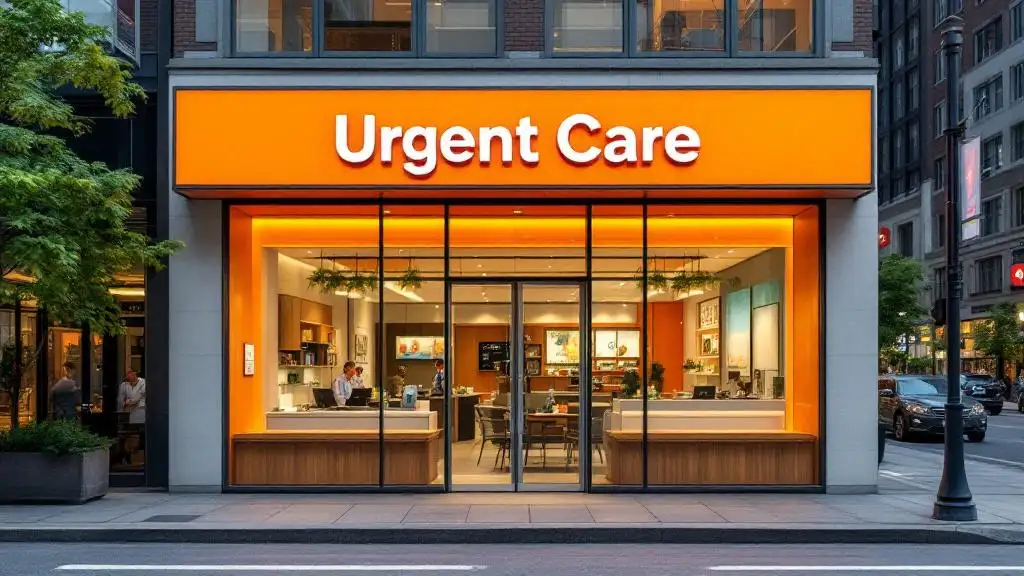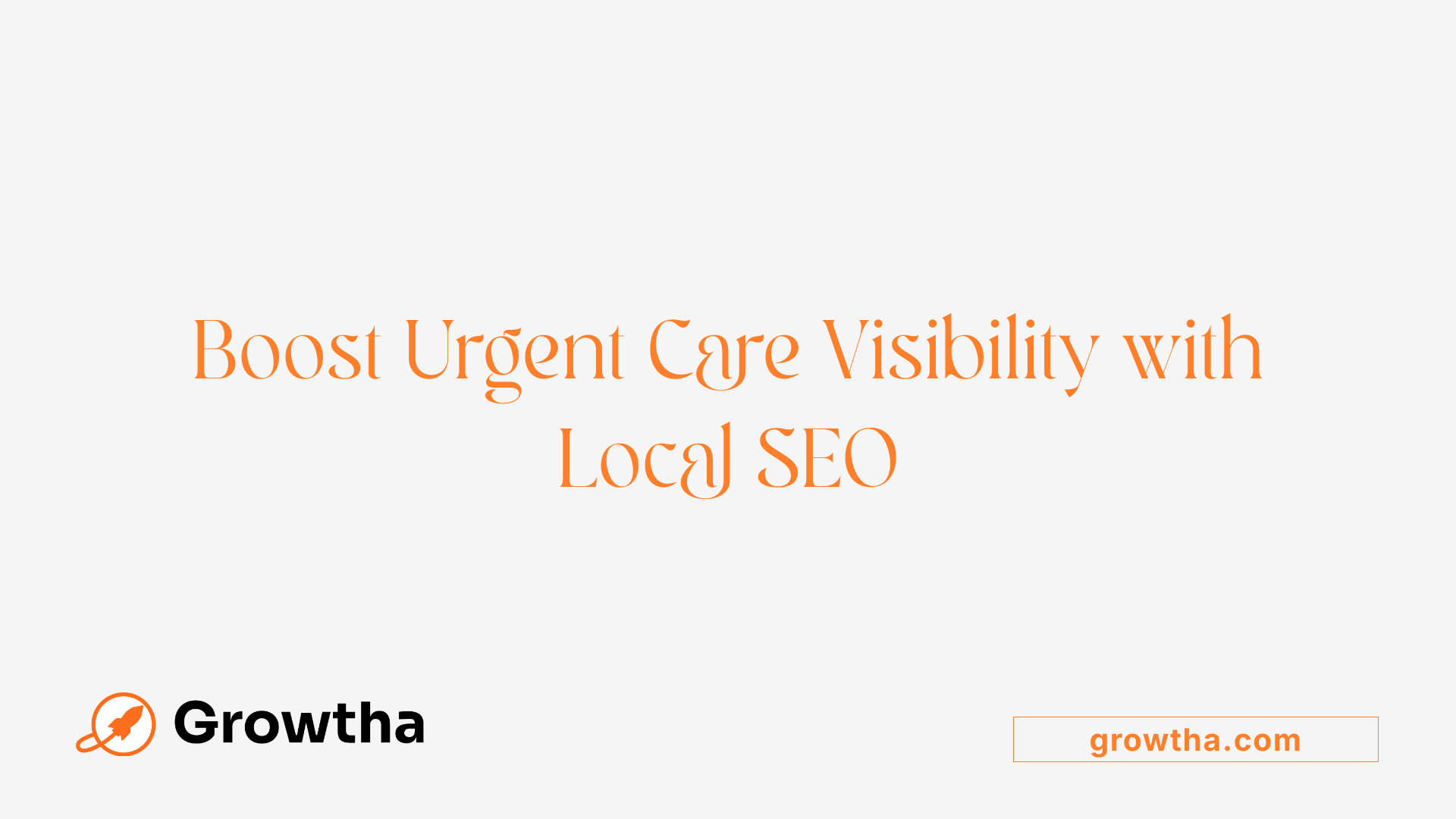SEO Tips for Urgent Care Centers
Boosting Visibility: Essential SEO Strategies for Urgent Care Centers


SEO Tips for Urgent Care Centers
Understanding the Importance of SEO in Healthcare
In the highly competitive healthcare landscape, especially for urgent care centers, establishing a strong online presence is vital for attracting new patients and maintaining trust within the community. Search Engine Optimization (SEO) serves as a cornerstone for increasing visibility on search engines like Google, ensuring that potential patients find your clinic when they need immediate care. Implementing comprehensive SEO tactics can dramatically enhance your clinic's reach, credibility, and patient engagement.
Comprehensive SEO Strategies for Healthcare Providers
What are the general SEO strategies healthcare providers should implement?
Healthcare providers, especially urgent care clinics, can significantly improve their online visibility by adopting a well-rounded SEO approach. This includes creating high-quality, relevant content that addresses common patient concerns and incorporates target keywords. For local SEO, it’s crucial to optimize for specific location terms like "urgent care near me" or "emergency clinic in [Your City]," which helps attract nearby patients actively searching for immediate care.
Technical website optimization is also vital. Fast load speeds, mobile responsiveness, and the use of schema markup improve user experience and make websites more attractive to search engines. For example, optimizing images, leveraging browser caching, and implementing AMP frameworks can boost site speed and accessibility.
Managing local listings is another important step. Claiming and updating Google My Business profiles with accurate information, including operating hours, contact details, and services offered, ensures consistency across platforms. Maintaining NAP (Name, Address, Phone Number) consistency and gathering positive reviews on Google and other review sites enhance local rankings and build patient trust.
Building backlinks from reputable health-related websites increases domain authority, signaling credibility to search engines. Engaging content such as blogs, videos, and infographics shared via social media platforms can attract organic traffic and establish the clinic’s expertise.
Finally, ongoing performance monitoring using tools like Google Analytics and Search Console is essential. Tracking metrics such as website traffic, keyword rankings, and review metrics helps in refining strategies, adapting to search engine algorithm updates, and continually improving patient outreach.
This comprehensive approach combines on-page, off-page, technical, and local SEO tactics, making the practice more discoverable and trusted in the digital space, ultimately leading to increased patient engagement and growth.
Addressing User Intent with Targeted Content
 For urgent care clinics seeking to boost their online visibility through SEO, creating content that accurately aligns with user search intent is vital. Developing blogs and frequently asked questions (FAQs) addressing common health concerns not only enhances relevance but also positions the clinic as a trusted authority.
For urgent care clinics seeking to boost their online visibility through SEO, creating content that accurately aligns with user search intent is vital. Developing blogs and frequently asked questions (FAQs) addressing common health concerns not only enhances relevance but also positions the clinic as a trusted authority.
Location-specific service pages are also essential. These pages should target local keywords, such as "urgent care in [City]" or "walk-in clinic near [Neighborhood]," making it easier for nearby patients to find the clinic when they search for immediate medical help.
Incorporating keywords related to symptoms and treatments helps match patient queries with your content. Examples include terms like "flu treatment in [City]," "cough and cold urgent care," or "sports injury clinic," which align with what patients are actively searching for.
Educational content addresses patient questions, builds trust, and encourages long-term engagement. Blog posts about recognizing symptoms, when to visit urgent care, and treatment options improve organic search rankings and reinforce your clinic’s authority.
Adding multimedia elements such as videos, infographics, and visuals can increase user engagement. For instance, short videos explaining common conditions or process walkthroughs can make your content more accessible and shareable.
What are effective SEO strategies for healthcare providers? Effective strategies involve producing high-quality, optimized content that uses targeted keywords naturally within headings, meta descriptions, and content. Structuring your website with a clear hierarchy, utilizing descriptive URLs, and internal linking to relevant pages helps both users and search engines understand your site. Technical SEO elements—such as submitting sitemaps, implementing schema markup, and ensuring fast load times—are essential foundation steps. Building authority through backlinks, reviews, and social proof further boosts your rankings. Staying up-to-date with trends like voice search and emphasizing helpful, trustworthy content help maintain long-term SEO success, ultimately attracting more local patients and increasing your clinic’s visibility.
The Critical Role of Local SEO for Urgent Care Centers

Why is SEO important for urgent care centers?
SEO is essential for urgent care centers because it boosts their visibility when local patients search for immediate medical services. With more people using search engines to find nearby clinics, strategies like optimizing Google My Business profiles, targeting location-specific keywords, and maintaining consistent business information across online directories ensure that clinics appear prominently in search results.
Mobile friendliness is a vital component since most urgent care searches happen on smartphones. Fast-loading, responsive websites improve user experience and rank higher in search results. Encouraging satisfied patients to leave reviews on platforms like Google enhances credibility and influences ranking positively.
Creating relevant content, such as blogs and FAQs tailored to common health concerns, not only builds trust but also helps the clinic appear in relevant searches. All these efforts work together to attract more organic traffic, increase community trust, and make it easier for patients to find urgent care centers exactly when they need them.
How does optimising the Google My Business profile help?
Optimizing the Google My Business (GMB) profile is a cornerstone of local SEO for urgent care clinics. Ensuring the profile has a compelling description, current photos, and recent updates about new services or health tips improves visibility in local searches. Regularly posting relevant content and engaging with reviews sustains the profile’s attractiveness to both search engines and potential patients.
What is the importance of targeting emergency and location-specific keywords?
Focusing on keywords like "urgent care near me" and specific city or neighborhood terms helps clinics rank in local map results and drives immediate traffic. These keywords match the search intent of patients seeking urgent care quickly, especially during emergencies.
Why is maintaining consistent local NAP details crucial?
Keeping the Name, Address, and Phone Number (NAP) uniform across all online listings ensures search engines understand the clinic’s exact location. Inconsistent or outdated information can reduce rankings and confuse patients, negatively impacting reputation and visibility.
How do location-specific landing pages and schema markup contribute?
Creating dedicated landing pages for each service area with localized content improves relevance. Implementing schema markup provides search engines with structured information about the clinic’s location and services, which enhances appearance in local search results and Google Maps.
What is the benefit of building local backlinks?
Establishing backlinks from community websites, local news outlets, or health organizations increases domain authority. These reputable links signal trustworthiness to search engines, helping the clinic appear higher in local search rankings.
| Strategy | Description | Benefit |
|---|---|---|
| Google My Business Optimization | Complete profile, regular posts | Higher local visibility |
| Reviews & Testimonials | Encourage patient reviews | Boosts credibility and rankings |
| Local Keyword Targeting | Use of 'urgent care near me' | Attracts immediate search traffic |
| Consistent NAP Info | Uniform info across directories | Improves search accuracy |
| Location Pages & Schema | Localized pages with schema markup | Enhances local relevance |
| Local Backlinks | Links from community sites | Improves domain authority |
Effective local SEO strategies make urgent care centers more accessible to nearby patients, ensuring they appear at the top of search results when every second counts.
Website Optimization and Content Creation for Healthcare Facilities

What are important considerations for website optimization and content creation tailored for healthcare facilities?
Creating a highly effective website for healthcare facilities like urgent care clinics involves several critical components. First, the design must be user-friendly and mobile-responsive, ensuring visitors can easily navigate the site on any device. This is especially important since most patients search for urgent care services on smartphones. Accessibility is also vital, so adhering to WCAG and ADA guidelines allows all users, including seniors and those with disabilities, to access content comfortably.
Security is paramount. Implementing HIPAA-compliant portals, secure SSL certificates, and clear privacy policies not only protect patient information but also build trust. Fast page loading speeds are essential; optimizing images, leveraging caching, and minimizing code help reduce load times, providing a seamless experience.
Clear calls to action—such as online appointment booking, quick contact options, and visible phone numbers—guide patients toward essential services effectively.
Content should be authoritative and tailored to patient needs. Producing high-quality, educational material like FAQs, health tips, and condition management guides informs patients and supports SEO efforts. Incorporating multimedia elements like relevant images and videos can boost engagement and improve time spent on the site.
Local SEO is crucial for visibility in nearby searches. This includes using schema markup, accurate citations, and local keywords to help the site rank higher in local search results. Regularly updating blog content and keeping online listings current demonstrates activity and relevance, encouraging both search engines and patients to view the practice as trustworthy and active.
Combining these strategies results in a robust online presence that attracts more local patients, fosters trust, and encourages ongoing engagement.
Educating Healthcare Providers on Managing Online Presence

How can healthcare providers educate themselves about managing their online presence effectively?
Healthcare providers can take proactive steps to learn how to manage their online reputation and digital presence effectively. One of the first steps is to follow professional guidelines and standards set by reputable organizations such as the American Medical Association (AMA) and the Federation of State Medical Boards (FSMB). These organizations offer valuable resources emphasizing professionalism, confidentiality, and responsible use of social media.
Staying current with digital marketing trends is essential in the fast-changing online landscape. Providers should participate in industry-specific training sessions, webinars, and workshops that focus on digital health literacy and marketing best practices. Utilizing social media management and analytics tools can help track engagement, monitor reviews, and optimize content strategies.
Maintaining accurate, up-to-date profiles on platforms like Google Business Profiles, Yelp, and health-specific directories is crucial. Regularly monitoring and responding to reviews—both positive and negative—builds trust and demonstrates a commitment to patient satisfaction.
Creating and sharing high-quality, compliant content helps establish authority and trustworthiness. This content should align with legal and ethical standards, such as HIPAA, and focus on educating patients about common health concerns and services offered.
Engagement with the community through social media, online forums, and local events enhances visibility and relationships. Providers should also seek continuing education in digital health literacy, understanding how to navigate online reputational challenges and leverage online platforms to attract and retain patients.
By integrating these strategies, healthcare professionals can manage their online presence confidently, ensuring their digital footprint reflects professionalism and excellence in care.
More info: Searching for
Ensuring Faster Rankings and Prompt Visits
To ensure healthcare websites reach higher search rankings quickly, providers must adopt a comprehensive SEO approach. A foundational step involves thorough keyword research to identify both broad and specific search terms that patients frequently use when seeking urgent care, such as ‘urgent care near me’ or ‘walk-in clinic.’ These keywords should be incorporated naturally into page titles, headers, URLs, and content.
Optimizing site speed and ensuring mobile responsiveness are critical. Fast-loading sites with a user-friendly, mobile-friendly design improve user experience and are favored by search engines. Techniques like compressing images, leveraging caching, and using Accelerated Mobile Pages (AMP) can significantly reduce load times.
Local SEO efforts, such as claiming and maintaining a detailed Google My Business profile, are vital for visibility in local searches. Consistent NAP (Name, Address, Phone Number) information across directories, managing citations, and generating positive reviews also boost local rankings.
Building high-quality backlinks from reputable health-related websites enhances domain authority. In addition, creating relevant, authoritative content regularly — such as health blogs and FAQ pages tailored to patient concerns — signals expertise and keeps content fresh.
Structured data markup helps search engines better understand the site content and can lead to rich snippets, increasing click-through rates. Tracking performance through analytics tools like Google Analytics and Search Console allows providers to monitor keyword rankings, website traffic, and conversion metrics, informing ongoing strategy adjustments.
Regular content updates, coupled with active reputation management—responding to reviews and maintaining patient trust—are essential to sustain and improve search positioning. This multi-faceted approach ensures faster ranking improvements and more immediate patient visits, transforming digital presence into tangible health service outcomes.
Strategic Content and Marketing Planning for Long-Term Success

Developing a content calendar targeting key services
Creating a structured content calendar helps urgent care clinics plan and publish blogs, videos, and updates that highlight their core services like flu shots, physical exams, and injury treatments. Regularly updating this content not only improves SEO but also keeps patients informed about their options.
Balancing SEO with patient engagement
Effective marketing combines keyword-rich content with interactive elements that engage patients. This includes FAQs, health tips, and online appointment options, which improve visibility and build trust.
Using social media and email campaigns
Active social media profiles on platforms like Facebook and Instagram, paired with targeted email newsletters, foster ongoing patient relationships. Sharing health tips, clinic news, and patient testimonials encourages community engagement.
Leveraging community events and partnerships
Participating in local health fairs, sponsoring community events, and collaborating with partner clinics can significantly boost visibility. These activities position the clinic as a trusted community resource and generate new patient referrals.
Tracking and adjusting strategies through analytics
Utilizing tools like Google Analytics and search console allows clinics to monitor website traffic, engagement, and conversion rates. Regular analysis helps refine SEO and marketing efforts for sustained growth.
Highlighting unique selling points and patient testimonials
Showcasing what sets your urgent care apart, such as rapid response or family-friendly services, can attract new patients. Prominently featuring patient reviews enhances credibility and trust.
Producing multimedia content for engagement
Videos, infographics, and virtual tours make your online presence more dynamic. Educational videos about symptoms or procedures can improve patient understanding and increase appointment bookings.
When is the best time to visit urgent care to receive faster service?
The best times to visit urgent care for quicker treatment are early mornings or weekdays, as these periods usually see fewer patients. Avoiding peak hours such as late afternoons, evenings, and weekends can help reduce wait times. However, for urgent symptoms like difficulty breathing, chest pain, or sudden severe headaches, immediate care should be sought regardless of timing. Planning visits during quieter hours for non-emergencies can ensure prompt attention and reduce frustration.
By implementing these strategic content and marketing tactics, urgent care clinics can establish a strong online presence, attract ongoing patient traffic, and ensure long-term success in a competitive healthcare landscape.
Achieving SEO Success in the Healthcare Sector
Implementing a robust SEO strategy tailored for urgent care centers is essential for standing out in a crowded health market. By combining local optimization, high-quality content, technical excellence, reputation management, and ongoing performance analysis, clinics can attract more local patients, foster trust, and build long-term community relationships. A proactive, data-driven approach to SEO—not only boosts search rankings but also enhances overall patient experience and operational efficiency. As healthcare continues to evolve in the digital age, staying ahead with innovative SEO practices will ensure urgent care centers remain accessible, reputable, and competitive for years to come.
References
- Urgent Care SEO - Patient Care Marketing Pros
- SEO for Urgent Care Clinics - How to Drive More Traffic to Your ...
- Urgent Care SEO for Non-marketers: What, Why, and How - Experity
- SEO for Urgent Care - Haden Interactive
- A Complete Guide to Local SEO for Healthcare Providers! - WillDom
- Proven SEO for Urgent Care Centers Costs $799/mon to $999/Mon
- Top SEO Strategies for Urgent Care Clinics







